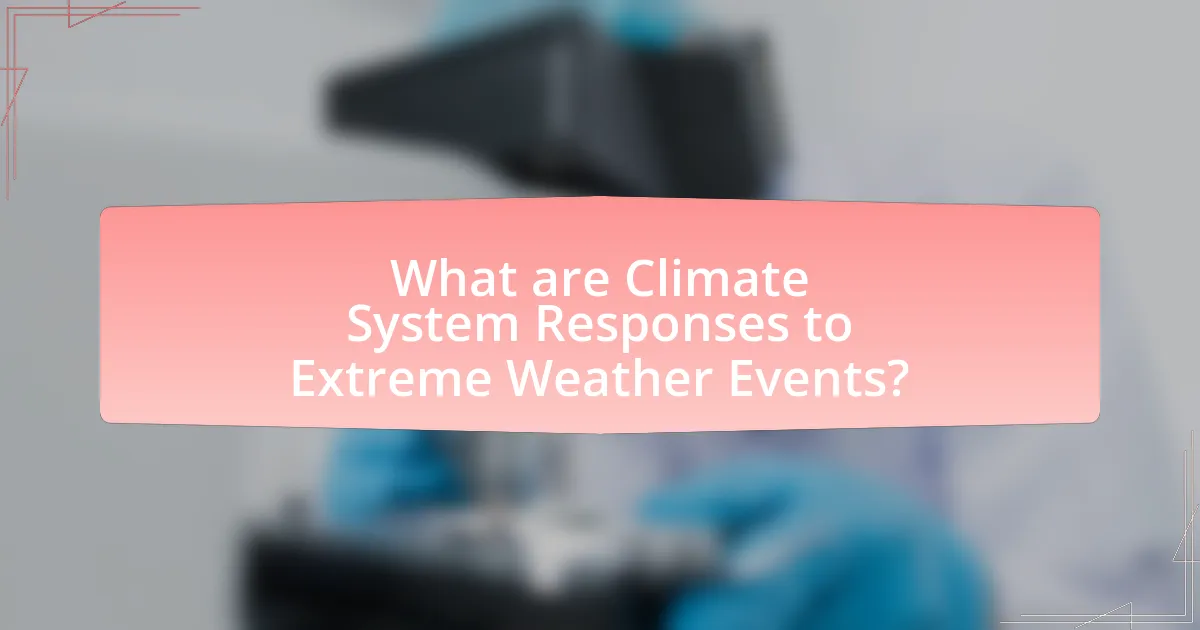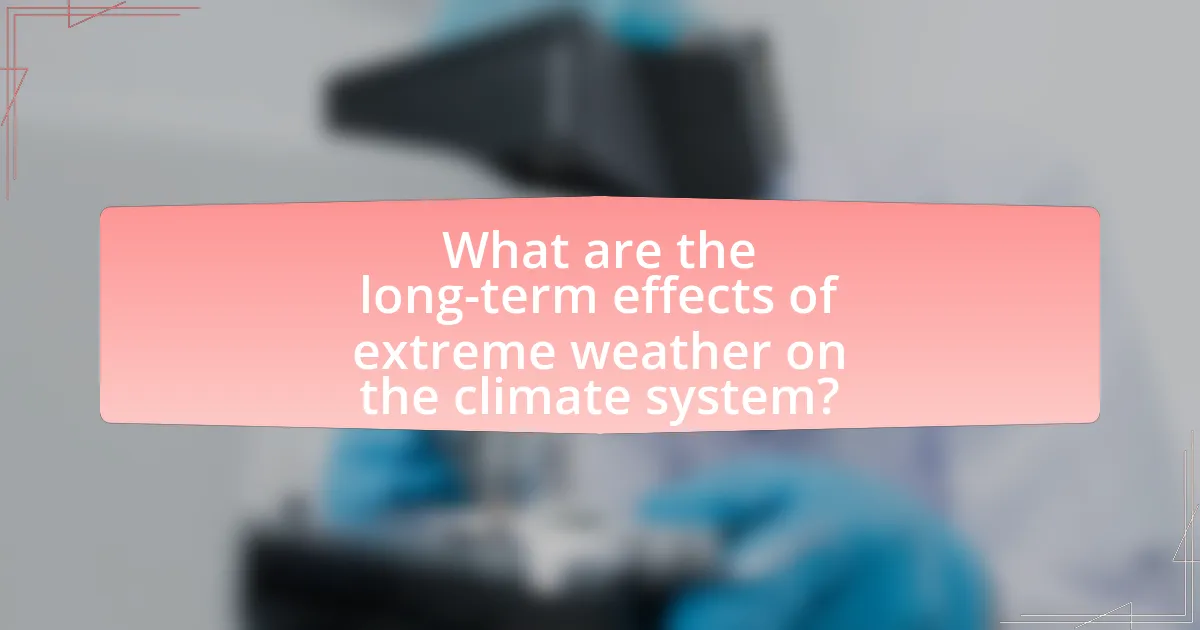The article focuses on climate system responses to extreme weather events, detailing how these events, such as hurricanes, floods, and droughts, alter temperature, precipitation patterns, and atmospheric circulation. It highlights the increasing frequency and intensity of these events due to climate change, as reported by the Intergovernmental Panel on Climate Change (IPCC). The article further explores the mechanisms driving these responses, including feedback loops and ocean-atmosphere interactions, and discusses their implications for ecosystems, human societies, and economies. Additionally, it emphasizes the importance of understanding these responses for effective climate adaptation and mitigation strategies.

What are Climate System Responses to Extreme Weather Events?
Climate system responses to extreme weather events include alterations in temperature, precipitation patterns, and atmospheric circulation. These responses are driven by the increased frequency and intensity of events such as hurricanes, floods, and droughts, which are linked to climate change. For instance, the Intergovernmental Panel on Climate Change (IPCC) reports that rising global temperatures contribute to more severe weather, leading to shifts in ecosystems and increased risks to biodiversity. Additionally, extreme weather can result in feedback loops, such as increased greenhouse gas emissions from wildfires, further exacerbating climate change.
How do extreme weather events impact the climate system?
Extreme weather events significantly disrupt the climate system by altering temperature patterns, precipitation rates, and atmospheric circulation. For instance, hurricanes can lead to increased sea surface temperatures, which in turn can intensify future storms, creating a feedback loop that exacerbates climate change. Additionally, extreme heatwaves can cause prolonged droughts, affecting water supply and agricultural productivity, while heavy rainfall events can lead to flooding, impacting ecosystems and human settlements. Research indicates that the frequency and intensity of these events are increasing due to climate change, as evidenced by the Intergovernmental Panel on Climate Change (IPCC) reports, which highlight a direct correlation between rising global temperatures and the occurrence of extreme weather phenomena.
What types of extreme weather events are most influential?
The most influential types of extreme weather events include hurricanes, droughts, floods, and heatwaves. Hurricanes, for instance, can cause widespread destruction and economic loss, with the National Oceanic and Atmospheric Administration (NOAA) estimating that Hurricane Katrina resulted in over $160 billion in damages. Droughts significantly impact agriculture and water supply, with the 2012 U.S. drought costing approximately $30 billion in losses. Floods, particularly flash floods, can lead to rapid loss of life and property; the 2010 Pakistan floods affected over 20 million people. Heatwaves contribute to health crises, with the European heatwave of 2003 resulting in an estimated 70,000 excess deaths. Each of these events has profound implications for ecosystems, economies, and human health, demonstrating their influential nature in the climate system.
How do these events alter atmospheric conditions?
Extreme weather events significantly alter atmospheric conditions by influencing temperature, humidity, and pressure patterns. For instance, hurricanes can lead to increased humidity and lower atmospheric pressure in their vicinity, which can disrupt local weather systems. Additionally, heatwaves raise surface temperatures, causing changes in air pressure and leading to altered wind patterns. Research indicates that these alterations can result in prolonged droughts or increased precipitation in different regions, as evidenced by the correlation between extreme weather events and shifts in climate patterns documented in the Intergovernmental Panel on Climate Change reports.
Why is understanding these responses important?
Understanding climate system responses to extreme weather events is crucial for effective climate adaptation and mitigation strategies. These responses provide insights into how ecosystems and human systems react to changes in climate, which can inform policy decisions and resource management. For instance, research indicates that understanding these responses can help predict future climate impacts, allowing for better preparedness and resilience planning. Accurate modeling of climate responses can lead to improved forecasting of extreme weather events, as demonstrated by studies from the Intergovernmental Panel on Climate Change, which highlight the correlation between climate variability and increased frequency of extreme weather.
What implications do these responses have for ecosystems?
The implications of climate system responses to extreme weather events for ecosystems include altered species distributions, disrupted food webs, and increased vulnerability to invasive species. These changes occur as extreme weather events, such as hurricanes and droughts, can lead to habitat destruction and shifts in the availability of resources. For instance, a study published in the journal “Nature” found that rising temperatures and changing precipitation patterns have caused shifts in plant and animal ranges, affecting biodiversity and ecosystem stability. Additionally, extreme weather can exacerbate stress on ecosystems, making them more susceptible to diseases and invasive species, which can further disrupt ecological balance.
How do they affect human societies and economies?
Extreme weather events significantly disrupt human societies and economies by causing damage to infrastructure, displacing populations, and impacting agricultural productivity. For instance, hurricanes can lead to billions of dollars in damages; Hurricane Katrina in 2005 resulted in over $125 billion in economic losses and displaced thousands of residents. Additionally, droughts can severely affect crop yields, leading to food shortages and increased prices, as seen during the 2012 U.S. drought, which caused an estimated $30 billion in agricultural losses. These disruptions not only strain local economies but also necessitate increased spending on disaster response and recovery, further impacting economic stability.
What mechanisms drive the climate system’s responses?
The mechanisms that drive the climate system’s responses include feedback loops, ocean-atmosphere interactions, and greenhouse gas concentrations. Feedback loops, such as the ice-albedo feedback, amplify warming by reducing reflective surfaces, leading to increased absorption of solar energy. Ocean-atmosphere interactions, exemplified by phenomena like El Niño and La Niña, significantly influence weather patterns and climate variability. Additionally, rising greenhouse gas concentrations, primarily from human activities, enhance the greenhouse effect, trapping more heat in the atmosphere and altering climate systems. These mechanisms are supported by extensive climate models and observational data, which demonstrate their critical roles in shaping climate responses to extreme weather events.
How do feedback loops influence climate responses?
Feedback loops significantly influence climate responses by amplifying or dampening the effects of climate change. For instance, the melting of polar ice reduces the Earth’s albedo, leading to increased absorption of solar energy and further warming, which exemplifies a positive feedback loop. This process is supported by data indicating that Arctic sea ice extent has declined by approximately 40% since the late 1970s, contributing to accelerated global temperature rise. Conversely, negative feedback loops, such as increased cloud cover from higher temperatures, can reflect sunlight and potentially moderate warming effects. These dynamics illustrate how feedback mechanisms are critical in shaping the climate system’s response to extreme weather events.
What are positive and negative feedback mechanisms?
Positive feedback mechanisms amplify changes in a system, while negative feedback mechanisms counteract changes to maintain stability. In the context of climate systems, a positive feedback example is the melting of polar ice; as ice melts, less sunlight is reflected, leading to increased warming and further ice melt. Conversely, a negative feedback example is the increase in cloud cover due to rising temperatures, which can reflect sunlight and help cool the Earth. These mechanisms are crucial in understanding climate responses to extreme weather events, as they influence the rate and extent of climate change.
How do these feedbacks interact with extreme weather events?
Feedback mechanisms in the climate system, such as the ice-albedo feedback and water vapor feedback, significantly amplify the intensity and frequency of extreme weather events. For instance, as global temperatures rise, ice melts, reducing the Earth’s albedo, which leads to further warming and more extreme heat events. Additionally, increased water vapor in the atmosphere, a result of higher temperatures, enhances precipitation and can lead to more intense storms and flooding. Research indicates that these feedbacks have contributed to the observed increase in the severity of hurricanes and heatwaves over the past few decades, with studies showing that warmer ocean temperatures correlate with stronger tropical cyclones.
What role do ocean currents play in climate responses?
Ocean currents significantly influence climate responses by redistributing heat across the planet, which affects weather patterns and climate systems. For instance, the Gulf Stream transports warm water from the tropics to the North Atlantic, moderating temperatures in Western Europe. This heat distribution is crucial for regulating global climate, as it impacts precipitation patterns and storm intensity. Research indicates that changes in ocean currents, such as those caused by climate change, can lead to more extreme weather events, including hurricanes and droughts, by altering the energy balance in the atmosphere.
How do changes in ocean temperatures affect weather patterns?
Changes in ocean temperatures significantly influence weather patterns by altering atmospheric circulation and moisture levels. Warmer ocean temperatures can lead to increased evaporation, resulting in more moisture in the atmosphere, which can intensify precipitation events and contribute to extreme weather phenomena such as hurricanes and heavy rainfall. For instance, the 2017 Atlantic hurricane season was notably active, with warmer sea surface temperatures contributing to the formation and intensity of storms like Hurricane Harvey, which caused unprecedented flooding in Texas. Additionally, shifts in ocean temperatures can disrupt established weather patterns, such as the El Niño and La Niña phenomena, which are linked to global climate variability and can lead to droughts or floods in various regions.
What is the significance of ocean-atmosphere interactions?
Ocean-atmosphere interactions are significant because they play a crucial role in regulating the Earth’s climate and weather patterns. These interactions influence phenomena such as El Niño and La Niña, which can lead to extreme weather events like hurricanes, droughts, and floods. For instance, the National Oceanic and Atmospheric Administration (NOAA) reports that El Niño events can increase the frequency and intensity of storms in certain regions, demonstrating the direct impact of ocean-atmosphere dynamics on climate variability.

What are the long-term effects of extreme weather on the climate system?
Extreme weather events have significant long-term effects on the climate system, primarily by altering temperature patterns, precipitation distribution, and ecosystem dynamics. These events, such as hurricanes, droughts, and floods, can lead to persistent changes in atmospheric circulation and ocean currents, which in turn affect global climate patterns. For instance, research indicates that increased frequency and intensity of extreme weather can contribute to long-term warming trends, as seen in the Intergovernmental Panel on Climate Change (IPCC) reports, which highlight that extreme heat events are becoming more common and are expected to continue influencing climate systems. Additionally, extreme weather can disrupt carbon sinks, such as forests and wetlands, leading to increased carbon dioxide levels in the atmosphere, further exacerbating climate change.
How do extreme weather events contribute to climate change?
Extreme weather events contribute to climate change by exacerbating the conditions that lead to increased greenhouse gas emissions and altering natural carbon sinks. For instance, intense storms and flooding can damage infrastructure and ecosystems, releasing stored carbon into the atmosphere. According to the Intergovernmental Panel on Climate Change (IPCC), extreme heat events can increase the frequency of wildfires, which release significant amounts of carbon dioxide and other greenhouse gases. Additionally, droughts can reduce the capacity of forests and soils to sequester carbon, further amplifying climate change effects. These interactions illustrate how extreme weather not only results from climate change but also actively contributes to its progression.
What evidence supports the link between extreme weather and climate change?
Evidence supporting the link between extreme weather and climate change includes increased frequency and intensity of events such as hurricanes, heatwaves, and heavy rainfall, which are documented in scientific studies. The Intergovernmental Panel on Climate Change (IPCC) reports indicate that as global temperatures rise, the atmosphere holds more moisture, leading to heavier precipitation events. For instance, a study published in the journal “Nature” by Trenberth et al. (2014) found that climate change has already increased the intensity of extreme rainfall events by 7% for every 1°C of warming. Additionally, the National Oceanic and Atmospheric Administration (NOAA) has reported that the number of category 4 and 5 hurricanes has increased since the 1980s, correlating with rising sea surface temperatures. These findings provide concrete evidence that climate change is influencing the occurrence and severity of extreme weather events.
How do these events influence global temperature trends?
Extreme weather events significantly influence global temperature trends by altering atmospheric conditions and energy distribution. For instance, heatwaves can lead to temporary spikes in regional temperatures, contributing to overall global warming patterns. According to the Intergovernmental Panel on Climate Change (IPCC), increased frequency and intensity of such events are linked to climate change, which raises average global temperatures. Additionally, phenomena like El Niño can disrupt normal weather patterns, causing fluctuations in global temperatures, as evidenced by historical data showing that El Niño years often correlate with higher global average temperatures.
What strategies can mitigate the impacts of extreme weather on the climate system?
Strategies to mitigate the impacts of extreme weather on the climate system include enhancing infrastructure resilience, implementing sustainable land-use practices, and investing in early warning systems. Resilient infrastructure, such as flood defenses and heat-resistant buildings, can reduce damage during extreme events. Sustainable land-use practices, like reforestation and wetland restoration, help absorb excess rainfall and reduce flooding risks. Early warning systems improve preparedness and response, minimizing human and economic losses. According to the Intergovernmental Panel on Climate Change (IPCC), these strategies can significantly lower vulnerability and enhance adaptive capacity in communities facing extreme weather.
What adaptive measures can communities implement?
Communities can implement adaptive measures such as enhancing infrastructure resilience, developing early warning systems, and promoting sustainable land use practices. Enhancing infrastructure resilience involves upgrading buildings and transportation systems to withstand extreme weather, which is crucial as studies show that resilient infrastructure can reduce damage costs by up to 50%. Developing early warning systems allows communities to prepare for extreme weather events, significantly decreasing response times and potentially saving lives. Promoting sustainable land use practices, such as reforestation and wetland restoration, can mitigate flooding and improve ecosystem health, as evidenced by research indicating that natural solutions can reduce flood risk by 30% in vulnerable areas.
How can policy changes support climate resilience?
Policy changes can support climate resilience by implementing regulations that promote sustainable practices and enhance adaptive capacity. For instance, policies that incentivize renewable energy adoption reduce greenhouse gas emissions, thereby mitigating climate change impacts. Additionally, land-use policies that prioritize green infrastructure, such as wetlands and urban forests, can buffer communities against extreme weather events. Evidence from the National Oceanic and Atmospheric Administration indicates that investments in resilient infrastructure can save communities up to $6 for every $1 spent on disaster preparedness. These policy frameworks not only foster immediate resilience but also contribute to long-term sustainability in the face of climate variability.
What are best practices for preparing for extreme weather events?
Best practices for preparing for extreme weather events include creating an emergency plan, assembling an emergency kit, and staying informed about weather forecasts. An emergency plan should outline evacuation routes, communication strategies, and designated meeting places for family members. Assembling an emergency kit with essentials such as water, non-perishable food, medications, flashlights, and first aid supplies ensures readiness. Staying informed through reliable sources like the National Weather Service allows individuals to receive timely updates and warnings, which is crucial for safety during extreme weather events. These practices are supported by data indicating that preparedness significantly reduces risks and enhances community resilience during disasters.


